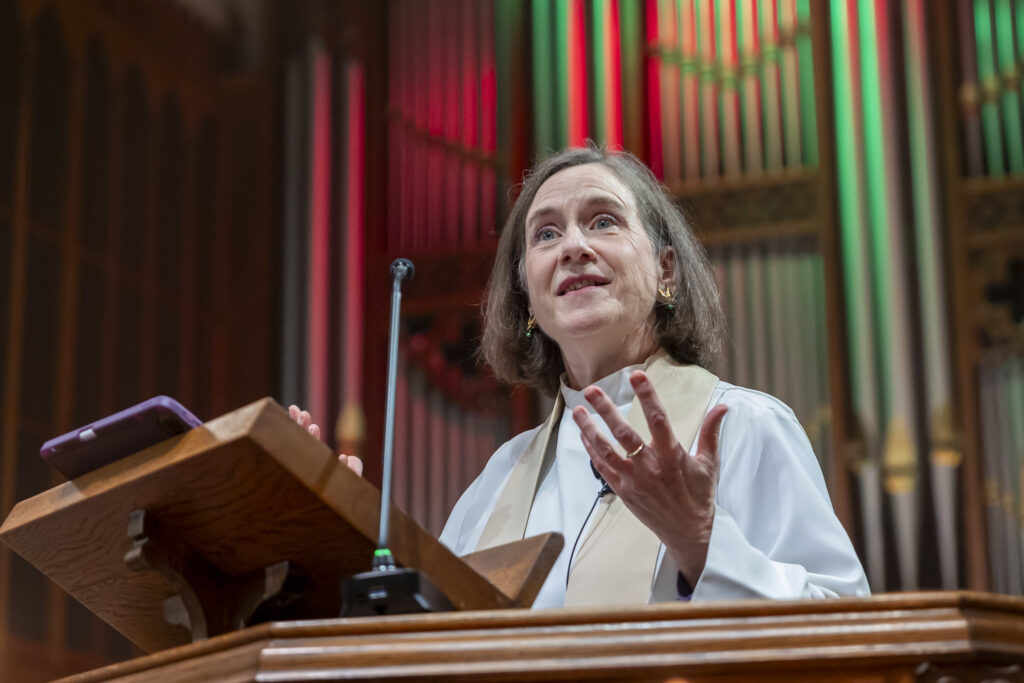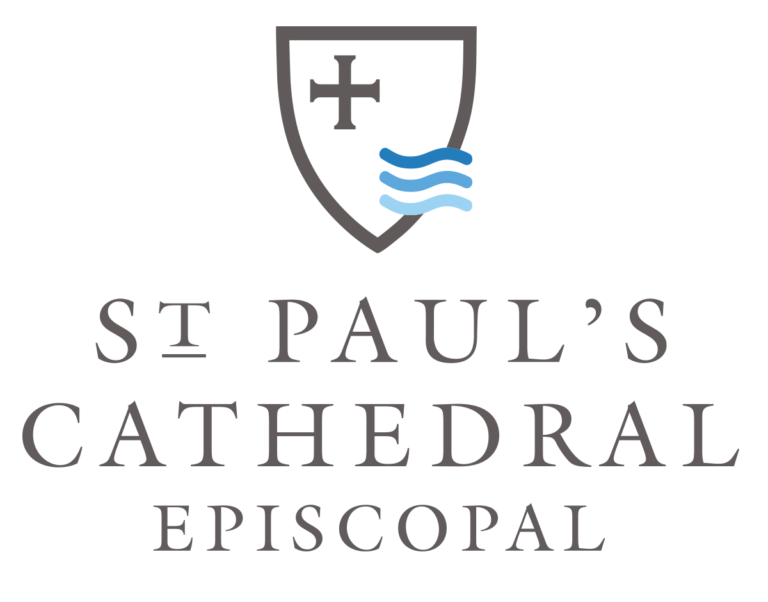
Penelope Bridges
“The Lord whom you seek shall suddenly come to his temple.” (Malachi 3)
The prophet Malachi prepares the ground for our Gospel today, in which St Luke takes us back to the great Temple in Jerusalem, the heart of his story of Jesus. Luke reminds us that it was customary under Jewish law for a new mother and baby to make certain sacrifices once the baby reached 40 days old. The Temple was God’s dwelling place on earth, the center of Jewish life, a place of prayer and piety. We might imagine something very like our own sacred space here: soaring stone columns, incense, quiet voices, orderly processions.
But the Temple was also a noisy, smelly, violent market place. People came from all over the Jewish world to pray, to sightsee, and above all to make sacrifices. There were the money-changers of course, ensuring that people making financial donations used only official Jewish currency. And every day, all day, people brought animals to be sacrificed for various rituals. The Temple was a slaughter house: a conveyor belt of death.
The Law of Moses laid out exactly which animals should be offered for each kind of purification ritual. A first-born son was supposed to be ransomed by a lamb, but there was also provision for those who couldn’t afford a whole lamb: they could bring a brace of pigeons instead. Blood was everywhere. Remember that blood was so sacred that it was never to be consumed: blood was life for the people of God. The blood of the animal was spilled as the price of the precious life of the firstborn. A sacrifice was also required for the mother, redeeming the blood lost in childbirth so that she could return to normal life.
Somehow, in all the cacophony, Mary and Joseph found themselves in the presence of Simeon, a respected elder, who was prompted by the Spirit to burst into song and offer an admittedly strange blessing for the holy child; and then Anna, a prophet we are told of a great age, who also recognized the Messiah and praised God for the revelation. The holy family, the two elders, all vulnerable people, humble people, people who were disregarded by those in power, coming together in this sacred and contradictory space to give thanks for the new thing that God was doing.
Anna and Simeon both recognize that God has come into their midst. The coming of God to God’s people is a blessing; but it’s also something to be feared, as the prophet Malachi makes clear in the Hebrew Scriptures reading. God’s power is like a refiner’s fire. God’s arrival means being reduced to our essence, and along the way exposed to our own sinfulness. This is what the powerful object to about prophetic preaching. This is why Elijah and Jeremiah were persecuted and why prophetic preachers in our own time are attacked and threatened. This is why Jesus was put to death. He exposed the hypocrisy and brokenness of the religious system of his time, and the keepers of the system, the people with a stake in its continuation, reacted with violence.
Anna and Simeon are unimportant people, almost invisible to the movers and shakers who sweep through the Temple with their robes and their retinues. Yet it’s Anna and Simeon who recognize Jesus, who are blessed with the gift of knowing that they have encountered God in God’s own house. When we dismiss one group of people as unworthy, defective or not fully human, we run the risk of dismissing the ones with spiritual sight, the ones whom God loves most.
I look around this sacred space and I see a sanctuary. That word, sanctuary, has multiple meanings in our world. It refers technically to the area behind the altar rail, that we also call the Chancel. For some Christian communities it refers to the entire worship space. And it has a conceptual meaning too, as a refuge from danger, and specifically a place where those who are being hunted by the authorities can find safety.
The church has for centuries provided sanctuary, whether to those unjustly accused, or to victims of domestic abuse, or to troubled souls seeking a place of quiet and welcome. While the sanctuary concept is no longer universally embraced, there is a longstanding convention for government entities to hold back from forcibly entering sacred spaces in search of those they would detain. In recent years this convention has been attacked at the highest levels of government, and a number of dioceses including our own have declared ourselves places of sanctuary, in particular for undocumented migrants in danger of being arrested and sent back into danger.
The resolution that our diocese passed in 2017 “stated that the diocese would stand alongside undocumented immigrants, oppose large-scale deportations, and encourage all diocesan congregations to explore becoming ‘sanctuary congregations and institutions.’ While Resolution 17-05 did not require uniform action, it does encourage each church community to discern its capacity and calling around a shared moral and theological imperative: to protect and uphold the worth of every person, regardless of immigration status.” (article on EDSD.org, Jan 28 2025) I encourage you to read the rest of the article published by our diocese this week: there’s a link to it in Thursday’s e-blast.
St. Paul’s hasn’t yet engaged with this discernment, but now may be the time. I was interviewed on the topic of sanctuary this week by a reporter from the San Diego Union Tribune. Chapter will need to wrestle with the possibility of our sanctuary being invaded. Are we willing to allow our sacred space to be disturbed by violent action, in the event that one of our neighbors or one of our members claims sanctuary and is chased into this building? How shall we react if that happens? And if not St. Paul’s, what if it happens at one of our sister churches that have many recent immigrants in their communities? Will we step forward to help?
As much as some of us would prefer not to get embroiled in the politics of the day, we may not be able to avoid it for much longer, as we see policies of cruelty and dehumanization pursued and the people we love intimidated and persecuted.
As I thought about Bishop Budde’s inaugural service homily this week I was prompted to reflect on what it means to serve as a priest. I went back to the sermon the Rev. Clare Fischer Davies preached at my ordination to the priesthood 27 years ago today. Clare said,
“The parish church is the place where we discover our resurrected selves; the place where we can catch a glimpse of the Holy City or experience the inbreaking wonder of the reign of God. The life of the church provides a context for people in which they may be no less than transformed – made new and whole and blessed. The parish church is where Christians come not just to hear about, but participate – to participate in the incredible story of a God who joins with human beings in history and who gives meaning and purpose to human lives through God’s own sacrificial love.” (Clare Fischer Davies sermon, February 2 1997, Grace Church, Alexandria VA)
Our gathering in this space each Sunday offers us the opportunity to be transformed and sent out into the world to represent the love of God, a love that gives our lives meaning and also gives this place meaning. How will that meaning inform our actions as individuals and as a community, if our neighbors and friends are threatened by cruel and unjust public policy?
Later in Clare’s sermon she addressed me by name – not an uncommon practice in sermons for special occasions – and she gave me my charge as a priest. She reminded me that my priestly identity would be formed in community with those I would serve and in all the sacred spaces of my ministry, whether at the altar, or in the pulpit, or at the hospital or at the street corner. This has proved to be true.
One of the great blessings of my ministry is to be steward of this sacred space and of what happens in here. All are welcome here – whether they are 2 months or 102 years old. Each of us honors the space in our own way: some sing, some do Episcopal aerobics, some remain seated and simply listen. Some build miniature churches in the prayground and some sneak glances at their email during the sermon.
Whether we sit in pews or chairs, whether the occasion is a sound bath or a fundraiser gala or a Eucharist service, whether we hear organ or guitars, the sacredness is preserved by the manner of life led by the people who call this home. The graffiti that desecrated our walls last week was put there by someone unable to recognize the sacredness of this space: we should pray for them. Those who would contemplate invading this space in search of undocumented immigrants are similarly unable. We should pray for them too.
In this community, brought together for healing, nurture, and challenge in the name of Christ, there is no room for cruelty, contempt, or disregard for the feelings of others. Unlike the ancient Temple, there is to be no violence of action or speech in this sacred space. Let this place be a sanctuary for all people, a respite from the violence out there. Let it be a place where Christ may be found, where we can share the peace that passes understanding and the love of our surprising, transforming, and lifegiving God.

